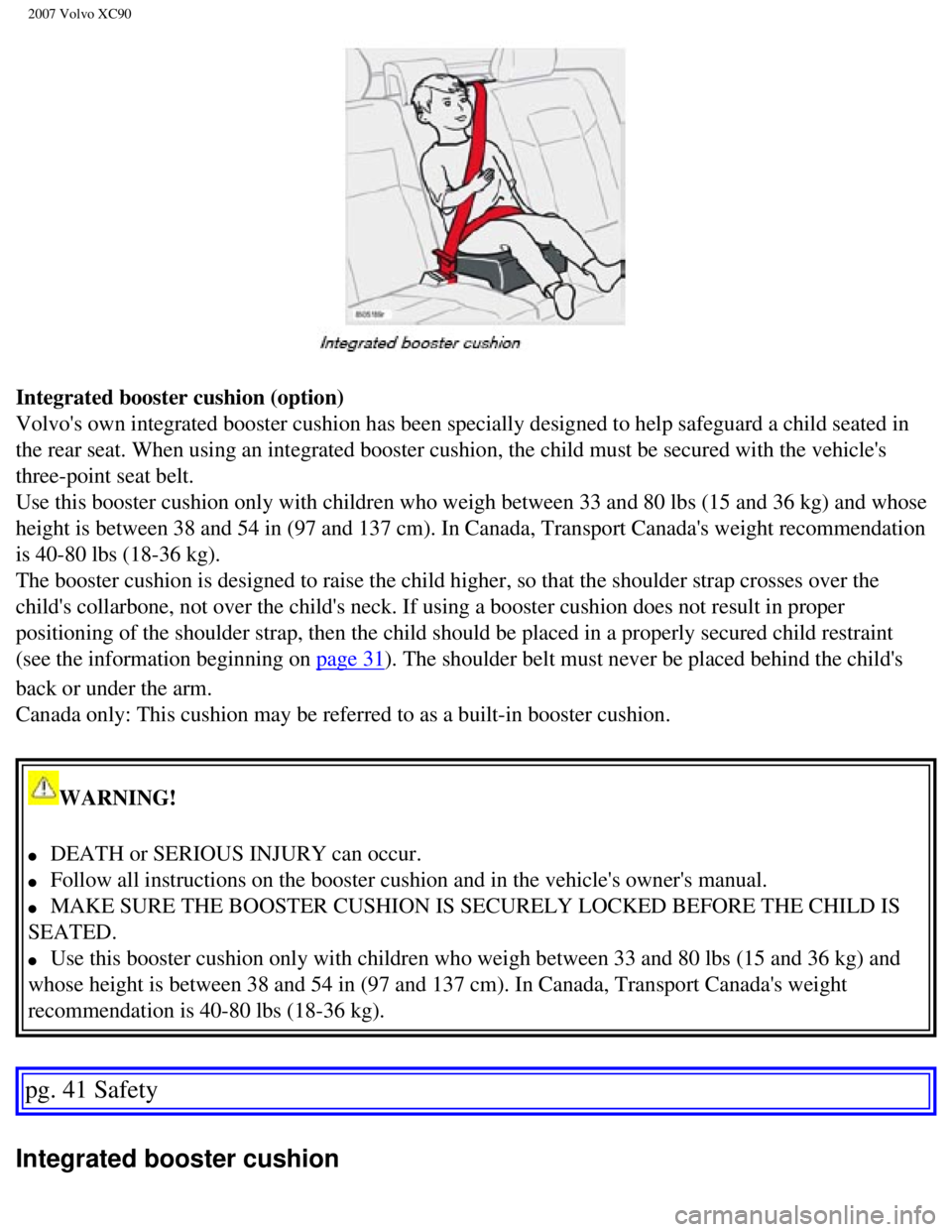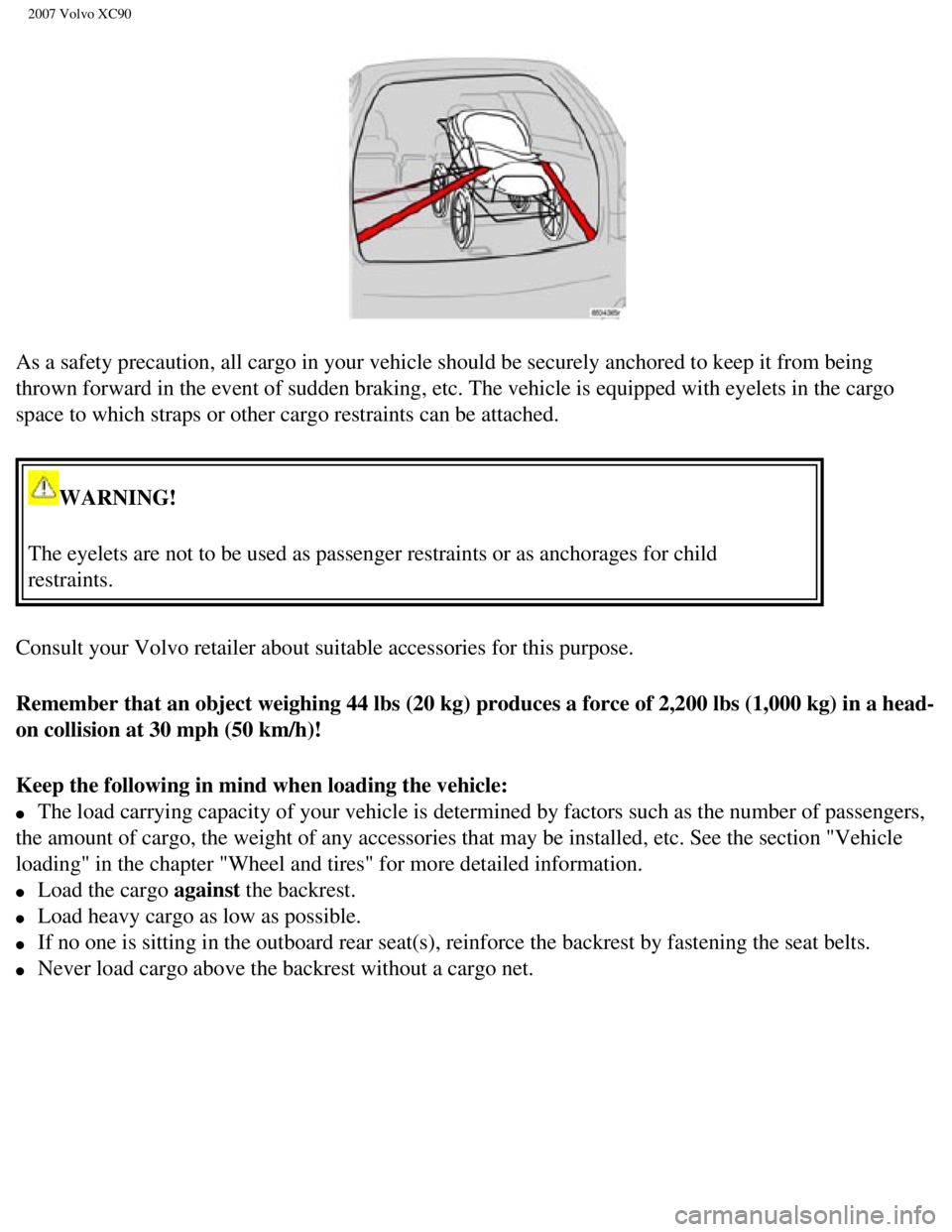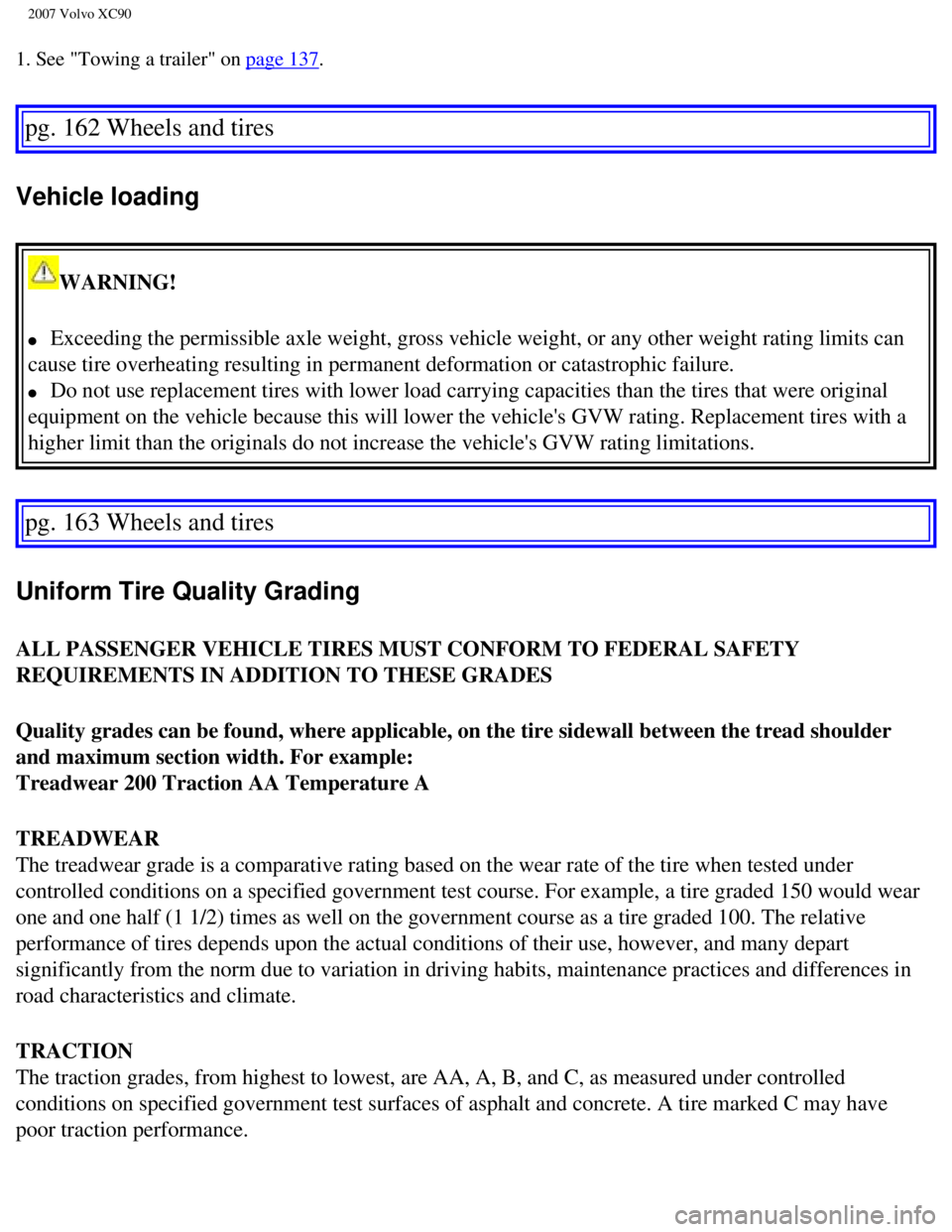2007 VOLVO XC90 weight
[x] Cancel search: weightPage 44 of 268

2007 Volvo XC90
Integrated booster cushion (option)
Volvo's own integrated booster cushion has been specially designed to he\
lp safeguard a child seated in
the rear seat. When using an integrated booster cushion, the child must \
be secured with the vehicle's
three-point seat belt.
Use this booster cushion only with children who weigh between 33 and 80 \
lbs (15 and 36 kg) and whose
height is between 38 and 54 in (97 and 137 cm). In Canada, Transport C\
anada's weight recommendation
is 40-80 lbs (18-36 kg).
The booster cushion is designed to raise the child higher, so that the s\
houlder strap crosses over the
child's collarbone, not over the child's neck. If using a booster cushio\
n does not result in proper
positioning of the shoulder strap, then the child should be placed in a \
properly secured child restraint
(see the information beginning on
page 31). The shoulder belt must never be placed behind the child's
back or under the arm.
Canada only: This cushion may be referred to as a built-in booster cushi\
on.
WARNING!
l DEATH or SERIOUS INJURY can occur.
l Follow all instructions on the booster cushion and in the vehicle's owne\
r's manual.
l MAKE SURE THE BOOSTER CUSHION IS SECURELY LOCKED BEFORE THE CHILD IS
SEATED.
l Use this booster cushion only with children who weigh between 33 and 80 \
lbs (15 and 36 kg) and
whose height is between 38 and 54 in (97 and 137 cm). In Canada, Trans\
port Canada's weight
recommendation is 40-80 lbs (18-36 kg).
pg. 41 Safety
Integrated booster cushion
file:///K|/ownersdocs/2007/2007_XC90/07xc90_01.htm (37 of 39)12/30/200\
6 5:53:34 PM
Page 111 of 268

2007 Volvo XC90
As a safety precaution, all cargo in your vehicle should be securely anc\
hored to keep it from being
thrown forward in the event of sudden braking, etc. The vehicle is equip\
ped with eyelets in the cargo
space to which straps or other cargo restraints can be attached.
WARNING!
The eyelets are not to be used as passenger restraints or as anchorages \
for child
restraints.
Consult your Volvo retailer about suitable accessories for this purpose.\
Remember that an object weighing 44 lbs (20 kg) produces a force of 2,\
200 lbs (1,000 kg) in a head-
on collision at 30 mph (50 km/h)!
Keep the following in mind when loading the vehicle:
l The load carrying capacity of your vehicle is determined by factors such\
as the number of passengers,
the amount of cargo, the weight of any accessories that may be installed\
, etc. See the section "Vehicle
loading" in the chapter "Wheel and tires" for more detailed information.\
l Load the cargo against the backrest.
l Load heavy cargo as low as possible.
l If no one is sitting in the outboard rear seat(s), reinforce the backr\
est by fastening the seat belts.
l Never load cargo above the backrest without a cargo net.
file:///K|/ownersdocs/2007/2007_XC90/07xc90_04.htm (17 of 23)12/30/200\
6 5:53:40 PM
Page 128 of 268

2007 Volvo XC90
WARNING!
Carbon monoxide is a poisonous, colorless, and odorless gas. It is prese\
nt in all exhaust gases. If you ever smell exhaust
fumes inside the vehicle, make sure the passenger compartment is ventila\
ted, and immediately return the vehicle to your
retailer for correction.
pg. 116 Starting and driving
Fuel requirements
WARNING!
Driving with the tailgate open: Driving with the tailgate open could lead to poisonous exhaust gases e\
ntering the
passenger compartment. If the tailgate must be kept open for any reason,\
proceed as follows:
l Close the windows
l Set the ventilation system control to air flow to floor, windshield and \
side windows and blower control to its highest
setting.
Weight distribution affects handling
At the specified curb weight your vehicle has a tendency to understeer, \
which means that the steering wheel has to be
turned more than might seem appropriate for the curvature of a bend. Thi\
s ensures good stability and reduces the risk of
rear wheel skid. Remember that these properties can alter with the vehic\
le load. The heavier the load in the cargo area, the
less the tendency to understeer.
Handling, roadholding
Vehicle load, tire design and inflation pressure all affect vehicle hand\
ling. Therefore, check that the tires are inflated to the
recommended pressure according to the vehicle load. See "Tire pressure" \
section. Loads should be distributed so that
capacity weight or maximum permissible axle loads are not exceeded.
Conserving electrical current
Keep the following in mind to help minimize battery drain:
l When the engine is not running, avoid turning the ignition key to positi\
on II (see page 121). Many electrical systems
(the audio system, the optional infotainment/ navigation systems, power\
windows, etc) will function with the ignition key
in position I. This position reduces drain on the battery.
l Please keep in mind that using systems, accessories, etc that consume a \
great deal of current when the engine is not
running could result in the battery being completely drained.
NOTE: A warning message will be displayed in the text window in the instrumen\
t panel when the battery charge is low.
pg. 117 Starting and driving
Refueling
file:///K|/ownersdocs/2007/2007_XC90/07xc90_06.htm (4 of 32)12/30/2006\
5:53:44 PM
Page 147 of 268

2007 Volvo XC90
Towing a trailer
The maximum weights recommended by Volvo for trailers with brakes are shown in the table below.
NOTE:
l Recommended hitch tongue load: not more than 10% of the trailer's weight\
. The trailer load should be positioned
so that it does not shift and the tongue load should be 10% of the trail\
er's weight. However, the tongue load should not
exceed the maximum permissible weights indicated in the table above.
l When towing trailers without brakes, the maximum permissible trailer weight is 1,700 lbs (750 kg).\
l If necessary, redistribute the weight of any cargo in the trailer to avo\
id excessive weight on the trailer hitch.
l The maximum trailer weight listed in the table for All Wheel Drive model\
s, 5,000 lbs (2250 kg) is only applicable when
there are not more than two occupants in the vehicle, in the front seats\
, with a combined weight of 300 lbs (135 kg), with
no other cargo in the vehicle.
l The maximum weight listed for Front Wheel Drive models, 4,000 lbs (1800\
kg) is only applicable when there are not
more than four occupants in the vehicle, in the front seats and second r\
ow of seats, with a combined weight of 600 lbs (270
kg), with no other cargo in the vehicle.
pg. 138 Starting and driving
Towing a trailer
l Please be aware that the load on the trailer hitch is part of the vehicl\
e's total load carrying capacity. The amount of cargo
in the vehicle and the trailer must be limited so that the gross vehicle\
weight and maximum permissible rear axle weight
(see
page 209) are not exceeded.
l Vehicles used for towing a trailer on a regular basis, or for long-dista\
nce highway towing should be equipped with an
automatic transmission oil cooler and Volvo's automatic self-leveling sy\
stem for the rear suspension. Consult your Volvo
retailer.
l Volvo recommends the use of Volvo trailer hitches that are specially des\
igned for the vehicle.
l All Volvo models are equipped with energy-absorbing shock-mounted bumper\
s. Trailer hitch installation should not
interfere with the proper operation of this bumper system.
l Increase tire pressure to recommended full inflation pressure. See chapt\
er "Wheels and tires."
l When your vehicle is new, avoid towing heavy trailers during the first 6\
20 miles (1,000 km).
l Engine and transmission are subject to increased loads. Therefore, engin\
e coolant temperature should be closely
file:///K|/ownersdocs/2007/2007_XC90/07xc90_06.htm (23 of 32)12/30/200\
6 5:53:44 PM
Page 150 of 268

2007 Volvo XC90
Positioning the load carriers
Make sure that the wing-shaped load carriers are installed on the roof r\
ails with the rounded edge forward (see the inset
illustration above). The load carriers are identical and can be placed \
anywhere along the roof rails.
When not in use, we recommend that the front load carrier be placed appr\
oximately 2 inches (5 cm) in front of the center
roof rail anchorage point and the rear load carrier approximately 1.5 in\
ches (3.5 cm) in front of the rear rail anchorage.
This will help to reduce wind noise.
NOTE: Volvo accessories mounted on these load carriers will require T-track m\
ounting hardware for correct installation.
Please consult your Volvo retailer.
Installing the load carriers
Make sure that the load carrier is pressed firmly out against the roof r\
ail. Screw the load carrier in place. Use the supplied
torque wrench and tighten to the mark on the wrench (corresponding to 6\
Nm). See illustration.
WARNING!
Loads carried on the vehicle's roof should not exceed 220 lbs (100 kg)\
, including the weight of the load carriers and any
other load carrying equipment (ski boxes, bicycle racks, etc.). Excess\
ive loads on the roof can adversely affect the
handling and roadholding characteristics of the vehicle.
pg. 142 Starting and driving
Load carriers (accessory)
file:///K|/ownersdocs/2007/2007_XC90/07xc90_06.htm (26 of 32)12/30/200\
6 5:53:44 PM
Page 168 of 268

2007 Volvo XC90
pg. 160 Wheels and tires
Glossary of tire terminology
l Tire information placard: A placard showing the OE (Original Equipment) tire sizes, recommende\
d
inflation pressure, and the maximum weight the vehicle can carry.
l Tire Identification Number (TIN): A number on the sidewall of each tire providing information
about the tire brand and manufacturing plant, tire size and date of manu\
facturer.
l Inflation pressure: A measure of the amount of air in a tire.
l Standard load: A class of P-metric or Metric tires designed to carry a maximum load a\
t 35 psi [37
psi (2.5 bar) for Metric tires]. Increasing the inflation pressure bey\
ond this pressure will not increase the
tires load carrying capability.
l Extra load: A class of P-metric or Metric tires designed to carry a heavier maximu\
m load at 41 psi
[43 psi (2.9 bar) for Metric tires]. Increasing the inflation pressure\
beyond this pressure will not increase
the tires load carrying capability.
l kPa: Kilopascal, a metric unit of air pressure.
l PSI: Pounds per square inch, a standard unit of air pressure.
l B-pillar: The structural member at the side of the vehicle behind the front door\
.
l Bead area of the tire: Area of the tire next to the rim.
l Sidewall of the tire: Area between the bead area and the tread.
l Tread area of the tire: Area of the perimeter of the tire that contacts the road when mounted \
on the
vehicle.
l Rim: The metal support (wheel) for a tire or a tire and tube assembly upo\
n which the tire beads are
seated.
l Maximum load rating: a figure indicating the maximum load in pounds and kilograms that can \
be
carried by the tire. This rating is established by the tire manufacturer\
.
l Maximum permissible inflation pressure: the greatest amount of air pressure that should ever be
put in the tire. This limit is set by the tire manufacturer.
l Recommended tire inflation pressure: inflation pressure, established by Volvo, which is based on
the type of tires that are mounted on a vehicle at the factory. This inf\
lation pressure is affected by the
number of occupants in the vehicle, the amount of cargo, and the speed a\
t which the vehicle will be
driven for a prolonged period. This information can be found on the tire\
inflation placard(s) located on
the driver's side B-pillar or on the inside of the fuel filler door on C\
anadian models, and in the tire
inflation table in this chapter.
l Cold tires: The tires are considered to be cold when they have the same temperatur\
e as the
surrounding (ambient) air. This temperature is normally reached after \
the vehicle has been parked for at
least 3 hours.
pg. 161 Wheels and tires
Vehicle loading
file:///K|/ownersdocs/2007/2007_XC90/07xc90_07.htm (12 of 23)12/30/200\
6 5:53:47 PM
Page 169 of 268

2007 Volvo XC90
Properly loading your vehicle will provide maximum return of vehicle des\
ign performance.
Before loading your vehicle, familiarize yourself with the following ter\
ms for determining your vehicle's
weight ratings, with or without a trailer, from the vehicle's Federal/ C\
anadian Motor Vehicle Safety
Standards (FMVSS/CMVSS) label, and the vehicle's tire information plac\
ard.
Curb weight
The weight of the vehicle including a full tank of fuel and all standard\
equipment. It does not include
passengers, cargo, or optional equipment.
Capacity weight
All weight added to the curb weight, including cargo and optional equipm\
ent. When towing, trailer hitch
tongue load is also part of cargo weight.
NOTE: For trailer towing information, please refer to the section "Towing a t\
railer" on
page 137.
Permissible axle weight
The maximum allowable weight that can be carried by a single axle (fron\
t or rear). These numbers are
shown on the Federal/Canadian Motor Vehicle Safety Standards (FMVSS/ CM\
VSS) label. The total
load on each axle must never exceed its maximum permissible weight.
Gross vehicle weight (GVW)
The vehicle's curb weight + cargo + passengers.
NOTE:
l The location of the various labels in your vehicle can be found on page 208.
l A table listing important weight limits for your vehicle can be found on\
page 209.
Steps for Determining Correct Load Limit
- Locate the statement "the combined weight of occupants and cargo shoul\
d never exceed XXX pounds''
on your vehicle's placard.
- Determine the combined weight of the driver and passengers that will b\
e riding in your vehicle.
- Subtract the combined weight of the driver and passengers from XXX kil\
ograms or XXX pounds.
- The resulting figure equals the available amount of cargo and luggage \
load capacity. For example, if
the "XXX'' amount equals 1400 lbs. and there will be five 150 lb. passen\
gers in your vehicle, the amount
of available cargo and luggage load capacity is 650 lbs. (1400- 750 (5\
x 150) = 650 lbs.)
- Determine the combined weight of luggage and cargo being loaded on the\
vehicle. That weight may
not safely exceed the available cargo and luggage load capacity calculat\
ed in Step 4.
- If your vehicle will be towing a trailer, load from your trailer will \
be transferred to your vehicle.
Consult this manual
1 to determine how this reduces the available cargo and luggage load capa\
city of
your vehicle.
file:///K|/ownersdocs/2007/2007_XC90/07xc90_07.htm (13 of 23)12/30/200\
6 5:53:47 PM
Page 170 of 268

2007 Volvo XC90
1. See "Towing a trailer" on page 137.
pg. 162 Wheels and tires
Vehicle loading
WARNING!
l Exceeding the permissible axle weight, gross vehicle weight, or any othe\
r weight rating limits can
cause tire overheating resulting in permanent deformation or catastrophi\
c failure.
l Do not use replacement tires with lower load carrying capacities than th\
e tires that were original
equipment on the vehicle because this will lower the vehicle's GVW ratin\
g. Replacement tires with a
higher limit than the originals do not increase the vehicle's GVW rating\
limitations.
pg. 163 Wheels and tires
Uniform Tire Quality Grading
ALL PASSENGER VEHICLE TIRES MUST CONFORM TO FEDERAL SAFETY
REQUIREMENTS IN ADDITION TO THESE GRADES
Quality grades can be found, where applicable, on the tire sidewall betw\
een the tread shoulder
and maximum section width. For example:
Treadwear 200 Traction AA Temperature A
TREADWEAR
The treadwear grade is a comparative rating based on the wear rate of th\
e tire when tested under
controlled conditions on a specified government test course. For example\
, a tire graded 150 would wear
one and one half (1 1/2) times as well on the government course as a t\
ire graded 100. The relative
performance of tires depends upon the actual conditions of their use, ho\
wever, and many depart
significantly from the norm due to variation in driving habits, maintena\
nce practices and differences in
road characteristics and climate.
TRACTION
The traction grades, from highest to lowest, are AA, A, B, and C, as mea\
sured under controlled
conditions on specified government test surfaces of asphalt and concrete\
. A tire marked C may have
poor traction performance.
file:///K|/ownersdocs/2007/2007_XC90/07xc90_07.htm (14 of 23)12/30/200\
6 5:53:47 PM